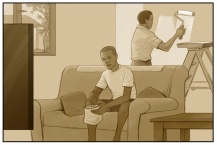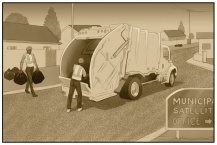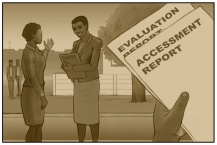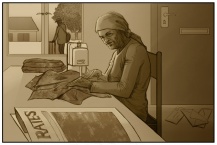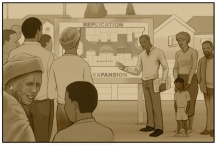Story 5: Maintenance and Improvement

MLS Contents
- Phases
- Sectors
- MLS story
- Story 1: Bulk Preparation
- Story 2: Basic Product
- Story 3: Aided Self Development
- Story 4: Upgrading
- Story 5: Maintenance and Improvement
Pam and her friends have now finally received government housing subsidies which were used to add to what they had already started. This is not the end of the process as incremental settlement never ends. People are always maintaining, modifying and improving their homes to suite their changing circumstances. All of the aided support interventions, started in the aided self development phase, now continue into the future. Lessons continue to be learnt and applied in future phases and projects. The incremental settlement approach is replicated and expanded. Pam’s experience is shared with others in the town, province, country and world.
Contents |
Continue with aided self development
Once the government helped us upgrade our houses, this was not the end of the process. We have continued to undertake many of the initiatives and programmes we started in the aided self development phase. For example:
- Twin Oaks Home Owners Association continues to meet and function. We have used the money we got from the municipality to pave our common street. (See the section on upgrade tenure, in phase 4 upgrading so see how we arranged for the municipality to provide us with some money for common space maintenance).
- There are still savings schemes in the community, but we are now discussing with the National network of Savings and Credit Cooperatives on how we can join and benefit from their experiences and work.
- A few of the bulk buying clubs are still operational and even after the houses were upgraded with government subsidies they continue to improve their homes.
- The permaculture garden group has expanded and is now a model project with visitors from other communities coming to see the gardening and permaculture projects that have been started.
- Some of the spaza shops and other small businesses have closed down, while others have expanded, and new ones started. With more people in the area now it is easier for people to start small businesses as there is a larger local market.
Much of the experience that the households and leadership of the schemes and associations have gained through this process has been used by people in the households to help them address other needs.
For example I have been told that more parents participate in parent associations in the local school in this neighbourhood than in all the other neighbourhoods in other townships. I think one of the reasons for this is that parents that were and are in committees established as part of the incremental settlement process now have more confidence and skills to participate in these structures.
There is now a group of households who are talking about establishing a garden owners’ cooperative, where they share garden equipment to keep their properties neat and tidy.
I am also involved in an energy cooperative that we have just started, where we plan to use a similar approach to the one that was used for the roof and water tanks to get solar hot water heaters for our homes. There is a company that is willing to provide a start-up grant so that we can establish an on-going loan fund for households to purchase solar hot water heaters. The department of energy is also looking at how they can help us with this programme.
Visit Housing for more information and discussion on this topic.
Continue with government services
The municipality has taken on more responsibility for maintaining the infrastructure and services that they provided.
Now that people have got individual ownership, they have to also pay rates to the municipality. They also have had to pay more service fees as they use more water and have access to more services.
Although government has got an indigent discount scheme where people who earn below a certain income are eligible to discounts on their rates and services, many households still struggle to afford to pay for the services provided by government (see section on affordability and sustainability for more on this).
In our block, the municipality collects the refuse from the edge of our block (and from the houses in other areas). The municipality maintains the roads and public spaces, although sometimes people complain about the pot holes. Many of the gravel roads have been upgraded to tar roads. The multipurpose social facility still provides a space for community meetings. The multipurpose small business centre also continues to be expanded.
The schools, clinics and other facilities are also continually being maintained and improved by the respective government departments. However, I hear from my friends involved in these schools and clinics that they are always complaining that they do not have enough money for proper maintenance and improvement.
Visit Neighbourhood Development for more information and discussion on this topic.
Diagnosis and planning
This Managed Land Settlement process we have followed in the Bongweni community has been an experiment or pilot project. As explained previously, the provincial Department of Human Settlements has been conducting evaluations throughout the process.
A formal evaluation exercise was done a few months after households moved onto the land after the basic development phase. Lessons from this experience were used to help design the housing project that was built on the municipal land.
As part of this first evaluation, households were asked to give their perceptions on the quality of the development process and the type of houses that were being built. Similar perceptions surveys were conducted in other communities that had received housing through other means like social housing and conventional RDP housing.
Three years later a similar perception survey was conducted in the communities that had been surveyed earlier. The findings noted that although the houses in our managed land settlement project may not have looked as neat as the RDP houses, households in the Bongani community were more satisfied that the houses and environment met their needs than the households in the other RDP housing projects.
There are plans to conduct a third survey now that governments housing subsidy has been used to add to the self built houses. This will give a useful time line for the whole upgrading incremental settlement process.
The Development Support Organisation is also conducting an evaluation of the process. The story I am narrating now is part of this evaluation exercise.
Many students have also conducted their own studies on different aspects of the housing project from permaculture in low cost housing, the gender implications of incremental settlement, to micro loans for incremental settlement. After each of these studies the results have been reported back to the community.
The study on how best to plan incremental houses was one of the more useful studies that many of the households used when planning their own house development prior to the housing subsidies arriving. This helped us make sure that when the housing subsidy came, this could be used to improve what we had started.
As households we were also able to modify our house plans as the project progressed. For example I was able to incorporate a nice braai area off our lounge that was not originally in our plans. We were also able to easily change one of our rooms into a ‘granny flat’ for my mother-in-law.
A small example of how diagnosis and planning has helped our household create a good environment, relates to the tree that was on our plot when we arrived. Under normal circumstances the tree would have been knocked down, but I decided to move my initial house a little to the side to accommodate this tree. Now more than 8 years later the tree is a central feature of our back yard, and has given us years of shade and interest.
Part of reflection is having a party celebrating what you have achieved. Housing development is a long process so you need to break it into smaller steps, and celebrate smaller milestones along the way like:
- Finding a potential piece of land
- Getting approval to develop this land
- Agreeing on tenure and services that will be provided as part of the basic product phase
- Moving onto the land and getting your occupation rights recognised
- Obtaining additional support from others during the self build phase, for house construction and gardening
- Getting approval for a housing subsidy to upgrade the area
- Transferring title deeds to households who want it
- Obtaining funds for a new school or other facility.
One of the big lessons I have learnt is that unless government or someone else steps in to fund organisations like Development Support Organisation, the technical and organisational support we received as community organisations will be sadly lacking, leading to the detriment of future projects.
Visit Land and Planning for more information and discussion on this topic.
Affordability and sustainability
The managed land settlement process has involved many sacrifices on our part. We have had to save consistently and there is always something more we have to pay for, be it saving to be able to pay for the basic water and sanitation, paying back the loan for the roof water harvesting package, savings for schools and Christmas, paying back loans to start small businesses, paying monthly fees to the municipality for services, etc.
The housing subsidies from government have helped us build better and bigger houses, and the indigent discount we get also helps but it’s still hard to break even financially each month.
Having my mother-in-law staying with us has also helped as she can help look after the children and help with the expenses using the money she makes from her sewing business.
The little things we have done all add up:
- Collecting roof water run-off in tanks, and using this in the house.
- Using the grey water to irrigate the fruit trees and banana circle
- Saving water by having a composting toilet and being able to use the compost for the garden
- Putting in ceiling insulation to save on heating costs in winter.
Themba has managed to develop his capacity as a builder during the process, and he now is able to get lots of smaller jobs helping people in the neighbourhood improve their houses. This helps us pay the bills and living expenses.
Some of my neighbours however have not been as lucky as us and have not been able to get good jobs. They have not been able to make the type of improvements to their homes as we have but they are still able to stay in their house. I think it has helped that people have not been able to just sell their rights of occupation to anyone, because people who are desperate are tempted to sell their houses cheaply to anyone, and then have to move to an informal settlement again. The same applies to people not being able to use their home as collateral, and then being dispossessed by the bank when they are unable to repay.
Although I know that some people say that owning a house allows one to get loans to improve your businesses and move up the property ladder. I am not convinced this is always the best for poor who more often move down the property ladder back into informal settlements.
The bus rapid transit system has also helped us save money on transport costs and governments new industrial zone nearby has brought a few jobs closer to us. This has all made it more affordable for us to live in this area.
Through some of the evaluation studies that have been done on the incremental settlement projects on the church and municipal land, it has been pointed out that the incremental settlement approach is also more financially sustainable for government because:
- Government is better able to plan how it spends its money over time. They know how much they can budget each year for the progressive upgrading of services and houses. For example when it came to top structure upgrading, they knew they could only afford to build a certain number of houses a year so split this over three years. The community knew what the plan was so they did not have to resort to service delivery protests to find out what was happening.
- Government is able to collect services fees from residents in Managed Land Settlement projects where it was harder to do this in informal settlements
- It is cheaper for government to upgrade planned managed land settlement areas compared to upgrading unplanned informal settlements. The water pipes and roads are usually straighter with fewer expensive bends. Few shacks and fences have to be moved to put in roads and pipes.
Government is able to at least provide more people with land and basic services at the start and then over time come back to help them improve what people have started to do for themselves.
One of the challenges for government however is finding and getting the land in well located areas on which to do Managed Land Settlement projects. Although our Managed Land Settlement pilot project was done on a large peripheral piece of land, the concept can also work on smaller infill pieces of land in more well located areas. Most of the incremental upgrading elements of the process can also occur on well located pieces of land people have found for themselves and started their own informal settlements.
Visit Financing for more information and discussion on this topic.
Replication and expansion
The incremental settlement approach is a broad concept that can flexibly be used in many different contexts, from inner city infill, to more suburban development, to peripheral development on the edge of cities, towns, and villages, as well as in more peri-urban and rural contexts.
I think that the concept needs to be expanded and replicated in many other areas, so that people who need land and housing can at least start now and get a secure piece of land with basic services. This stops people being passive recipients of government handouts and opens up opportunities for them to start to use their own resources to make progress in addressing their own needs.
With limited resources at governments disposal, government can effectively use what they have to provide more people with less (of a housing product), but with the knowledge that they will come back to help upgrade these areas in future. There is a chance that government may not come back later to upgrade, but it is up to the communities themselves to be organised and put pressure on government not to let this happen. It’s similar to the argument that could be made that government could provide some people with RDP houses now and then stop providing others with RDP houses in future. It’s up to those that don’t get RDP houses to put pressure on government to support them.
I have just been nominated to go on a study tour to a neighbouring country where I will explain to communities there about what we have done here; and I will also be able to learn how they have been addressing their housing needs, often with much less support from their government than us.
I never dreamed all those years ago when I was living in the small shack in Squatter Camp that I would be living in such a nice house and neighbourhood and be going on a trip out of the country. It just shows that anything is possible through organisation and hard work. I hope my story has motivated you to start your own story.
Visit Organising for more information and discussion on this topic.
Comments
Join the MLS conversation: Comments page

